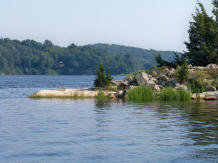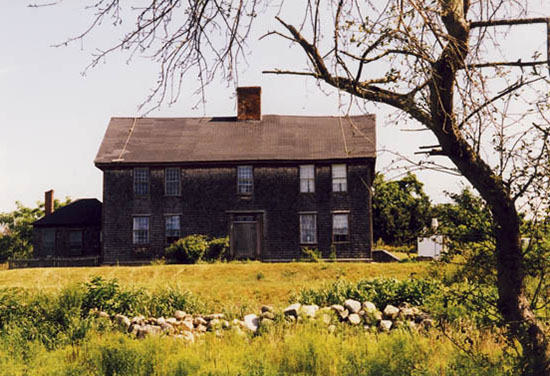The origins of Thomas Stanton in England are uncertain and there are several plausible theories about his pathway to Massachusetts Bay Colony. Our Thomas Stanton may have sailed on the Merchant Bonaventure on January 2, 1635, landing first in Virginia, but it is also possible that he came directly to Massachusetts on some other vessel. For recent information on this topic, please refer to magazine articles in The American Genealogist identified below.
Thomas Stanton probably arrived in Massachusetts before the end of 1635 and subsequently made his way to Hartford. He learned the fur trading business and became conversant in the Algonquian language which led to important assignments as an interpreter. The first official record of Stanton was his participation in a conference with the Pequot Indians at Fort Saybrook in July, 1636. He quickly affiliated with the Thomas Lord family whom he may have known in England and who had recently emigrated from Towcester, England. He married Anna Lord, probably in 1636 and established a merchant business alliance with Richard Lord.
During the Pequot War, Thomas provided service initially as an interpreter at Fort Saybrook. It was during the Fairfield Swamp Battle on July 14, 1637 that Stanton nearly lost his life. He arranged a temporary cease fire and managed to negotiate the surrender of 200 non-combatant Indians under a guarantee of safe passage. After these people passed beyond Thomas’ exposed, forward position, the 100 remaining Pequot warriors opened fire without warning and advanced toward him. He was rescued at the last moment by nearby colonial troops. Stanton was a delegate at the Treaty of Hartford ending the Pequot War in 1638 and, in 1643, was appointed Indian Interpreter for all of New England by the Commissioners of the United Colonies.
Thomas became a successful trading entrepreneur in Hartford involving fur and other commodities. In 1650, he was granted permission to establish a trading post on the Pawcatuck River with a 3 year trade monopoly. He moved his family from Hartford to New London in 1651 and then to Pawcatuck in 1657. From 1650-1675, Stanton continued to serve as interpreter and negotiator with the Indians. He was appointed to be a counselor for the Pequots and Mohegans and gained a reputation for supporting the fair treatment of Indian peoples. In one case, he protested the excessive reparations that were being demanded long after the end of the Pequot War. In another, he accused the Commissioners of the United Colonies of abandoning Mohegan Sachem Uncas and was censored for his effort. The respect that developed between Uncas and Stanton was evident when Thomas was asked to write Uncas’ will in 1670.

The Stanton family could not avoid the intensifying border conflict between Rhode Island and Connecticut since they owned property on both sides of the Pawcatuck River. Numerous confrontations occurred. In 1668, Thomas was appointed to meet with the Governor and council of Rhode Island to seek a solution to these problems but he was unsuccessful. The Stanton family also developed a significant trading operation with the West Indies. Two of his sons built ships, one on the Pawcatuck River and the other in Stonington. By the outbreak of King Philip’s war in 1675 Thomas was probably in poor health and unable to participate. Five of his sons however, served with distinction.
Thomas Stanton died on December 2, 1677 and his wife, Anna, in 1688. They had 10 children. Son, Robert inherited the new homestead that was built in 1672. The last individual owner of this home was Whit Davis who turned it over to the Stanton-Davis Homestead Museum, Inc. The goal is to preserve the building and establish a public museum.

Bibliography
Anderson, Robert Charles. The Great Migration: Immigrants to New England, 1634-1635, Vol VI, R-S. Boston: Published by the New England Historic Genealogical Society, 2009. pgs 467-479.
Cave, Alfred. The Pequot War. Amherst: The University of Massachusetts Press, 1996, p. 133.
Collections of the Massachusetts Historical Society. Vol. 10, Third Series. Boston: Published by the Society, Vol. 8, series 3, published 1882, p. 252.
DeForest, John. History of the Indians of Connecticut. Archon Books, 1964 (First edition published in 1851), pp. 149, 243.
Haynes, Williams. Stonington Chronology. Stonington: Pequot Press, 1949, p. 21.
Hooker, Roland. The Colonial Trade of Connecticut. Tercentenary Commission of the State of Connecticut, Booklet Number L (50). New Haven: Yale University Press, 1936, p. 2.
Love, William DeLoss. The Colonial History of Hartford. Hartford: The Case, Lockwood & Brainard Co., 1914, p. 32.
Radune, Richard A. Pequot Plantation, Branford, CT: Research In Time Publications, 2005. Consult the book’s index for numerous page references.
Stanton, William H. A Book Called Our Ancestors The Stantons. Philadelphia: Privately Printed, 1922, p. 18.
Stanton, William, PhD. A Record, Genealogical, Biographical, Statistical of Thomas Stanton of Connecticut and his Descendants. Albany, NY: Joel Munsell’s Sons, Pub., 1891
Wheeler, Richard. History of the Town of Stonington. New York: Noble Offset Printers, 1966, pp. 577, 578.
University of Connecticut Libraries. Colonial Connecticut Records, 1636-1776. Vols. I – IV. Digitized copy of Public Records of the Colony of Connecticut. University of Connecticut, 2000 – 2001, Vol. I, pp. 204, 205, 225-227, 300-303. Vol. II, pp. 531, 537.
Zubrinsky, Eugene C., “Thomas Stanton of Connecticut and the Longbridge Tradition.” The American Genealogist, Vol. 81, no. 1 (January 2006), 48-52 and “The Immigration and Early Whereabouts in America of Thomas Stanton of Connecticut.” The American Genealogist. Vol. 81, no. 4 (October 2006), 263-273
Also…
A number of our members have published information on Thomas Stanton.
Victoria Freeman has published
“Distant Relations: How My Ancestors Colonized North America”
There are over 100 pages devoted to Thomas’ life, which are based on her scholarly research. Here is a short excerpt of Chapter 8.
Newsletters with a great deal of Stanton family history have been published continuously since 1995. Digital copies of them are provided to Life Members. All members receive the ongoing issues of the newsletter. The Thomas Stanton Society has published 66 newsletters, as of Sept, 2022.
Richard Radune has published
Pequoit Plantation
…a book about the early history of Eastern CT.
